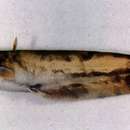Diagnostic Description
provided by Fishbase
The side of the dorsal is dark grey; white stomach; with irregular white dots on the side. One pair of maxillary barbel, longer than the head; one pair of mandibular barbels, about 1/5-1/3 the length of the maxillary barbel (Ref. 40516).
Life Cycle
provided by Fishbase
Pairs manifest spawning embrace widely observed in other catfish species (Ref. 37360).Details of reproductive behaviour from Katano, et al (1988): " A male first energeticaly pursued a female with its head near to the female's belly (chasing) and then began to cling to the female's body from the side, bending its tail or head (clinging). Finally the male enfolded the female's body, with its anus near to the female's (enfolding). In some cases, 2-4 males pursued a single female and two males enfolded a female at the same time. Although no aggressive behaviour was evident between males, it was always the largest male that could almost frequently approach and enfold the female. The mating pair moved a long distance in a ditch, paddy field and/or creek, performing reproductive activities."The scattering of eggs may reduce the incidence of death of the young.
Morphology
provided by Fishbase
Dorsal soft rays (total): 4; Analsoft rays: 67 - 84
Trophic Strategy
provided by Fishbase
Mostly found in rivers, lakes, and reserviors. Hide in swamps and caves during the day time and feeding during the night. Stays in deep waters and muddy places during winter (Ref. 40516). Feeds on all types of fish (Ref. 41072). Recorded as having been or being farmed in rice fields (Ref. 119549).
Biology
provided by Fishbase
Commercially cultured in Japan. Adults feed on all types of fish (Ref. 41072). Recorded as having been or being farmed in rice fields (Ref. 119549).
Importance
provided by Fishbase
fisheries: commercial; aquaculture: commercial
分布
provided by The Fish Database of Taiwan
分布於日本、中國大陸東部、朝鮮、東南亞。臺灣西部、南部的河川與池塘均有分布,但野生族群量已少,目前以南部養殖較多。
利用
provided by The Fish Database of Taiwan
為養殖食用魚種,肉嫩味美,通常以煮湯或紅燒,亦可燉中藥食之。
描述
provided by The Fish Database of Taiwan
體前部粗圓,尾部側扁,頭部寬平。吻短而寬圓。兩對鼻孔,前鼻孔有一根短管,近吻端。口裂大,上位,下頜稍突出。兩頜均有一行絨毛狀齒。幼魚時有鬚3對,成魚時下頜鬚退化僅有1對,上頜鬚比頭稍長,下頜鬚為上頜鬚長的1/3~1/5。體裸露無鱗,皮膚光滑。側線平直,沿體側中部而伸達尾基。黏液孔發達,成行排列於側線上方。背鰭短小,僅具5軟條;臀鰭長,後方與尾鰭相連,具70-85軟條;胸鰭具有1鋸齒狀之硬棘,12-14軟條。體呈暗灰色或灰黃色,體背側灰黑色,腹部白色,體側有不規則的白斑或不明顯的斑紋。
棲地
provided by The Fish Database of Taiwan
初級淡水魚。底棲性,主要棲息於水生植物叢生的靜水域或緩水流處。白天在草叢間或石縫洞穴中,夜間出來活動。肉食性魚類,性兇猛而貪食,以蝦、小魚及其他無脊椎動物為食。
Amur catfish
provided by wikipedia EN
The Amur catfish (Silurus asotus), also known as the Japanese common catfish,[2] is a species of catfish (sheatfish) in the family Siluridae. It is a large freshwater fish found in continental East Asia and Japan. It prefers slow-flowing rivers, lakes, and irrigation canals. Its appearance is typical of a large silurid catfish. Larval S. asotus specimens have three pairs of barbels (one maxillary, two mandibular), while adult fish have only two pairs (one maxillary, one mandibular); the second pair of mandibular barbels degenerates.[3] This species grows to 130 cm (51 in) in total length.
Culinary use
In Korean cuisine, the fish is called megi (메기) and is used to boil maeun-tang (spicy fish soup).
References
- Bibliography
- Notes

- license
- cc-by-sa-3.0
- copyright
- Wikipedia authors and editors
Amur catfish: Brief Summary
provided by wikipedia EN
The Amur catfish (Silurus asotus), also known as the Japanese common catfish, is a species of catfish (sheatfish) in the family Siluridae. It is a large freshwater fish found in continental East Asia and Japan. It prefers slow-flowing rivers, lakes, and irrigation canals. Its appearance is typical of a large silurid catfish. Larval S. asotus specimens have three pairs of barbels (one maxillary, two mandibular), while adult fish have only two pairs (one maxillary, one mandibular); the second pair of mandibular barbels degenerates. This species grows to 130 cm (51 in) in total length.
- license
- cc-by-sa-3.0
- copyright
- Wikipedia authors and editors

